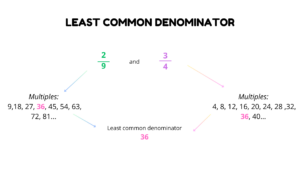Least common denominator
The least common denominator (LCD) is a fundamental concept in working with fractions. It refers to the smallest possible number that can be used as the denominator for all the fractions in a given set, allowing for easy comparison, addition, subtraction, and other operations.
Why it’s important:
- Makes comparing and manipulating fractions much easier.
- Addition and subtraction of fractions require the same denominator for accurate results.
- Simplifies calculations and avoids unnecessary confusion.
How to find it:
There are two main methods:
- Listing multiples: List the multiples of each denominator until you find the smallest number that appears in all lists.
- Prime factorization: Break down each denominator into its prime factors, then multiply the highest power of each prime factor present in any denominator. This is the LCD.

